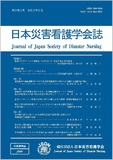Japanese
English
- 有料閲覧
- Abstract 文献概要
- 参考文献 Reference
- サイト内被引用 Cited by
要約
目的:本調査は被災3県の訪問看護ステーションの震災前後の災害への備えの実態を明らかにし,備えをより充実するための課題を検討する.
方法:震災前に開設し調査時に活動していた3県202訪問看護ステーションへ郵送法による無記名自記式質問紙調査を2018年2月に行った.備えの項目として施設用6項目,利用者用7項目,の実施有無他を質問した.
結果:65施設が回答し,緊急連絡網は多くの施設で整備されており,全体として施設と利用者への災害の備え項目実施数と率は震災後が高かった.利用者の備え項目実施率は施設のそれらより低かった.訓練や通信手段の確保など改善が進んでいない項目もあった.
結論:全体的に震災後に備えは強化されていた.訓練など実施率の改善されにくい項目があり,これらには施設内の対応だけでなく他機関間と連携を拡大し備えを充実させる必要が示唆された.
When a severe disaster occurs, elderly and disabled persons who receive home-visit nursing care services are the most vulnerable. Therefore, the agencies have to be thoroughly prepared for disasters. The current study was aimed to determine the levels of disaster preparedness among home-visit nursing agencies in three provinces pre- and post-the Great East Japan Earthquake, and to discuss possible approaches to enhance preparedness. We sent a questionnaire to 202 agencies in 3 prefectures that had started their services before the disaster to identify the implementation of disaster preparation items. We set six institutional items such as emergency communication network among staff and seven items for their clients such as confirmation of client's residential preparation. Almost all of the implementation rates were significantly higher post-disaster than pre-disaster. Some items, however, such as securing alternative communication tools when black-out and communication failure occurred, showed little improvement and it might be difficult to improve these without social support. In conclusion, although the overall level of disaster preparedness significantly improved after the disaster, better preparation is indispensable. To accelerate disaster preparedness, cooperation among agencies, their clients, their clients' families, and the community, including officials and other agencies, is absolutely vital.
Copyright © 2020, Japan Society of Disaster Nursing All rights reserved.


